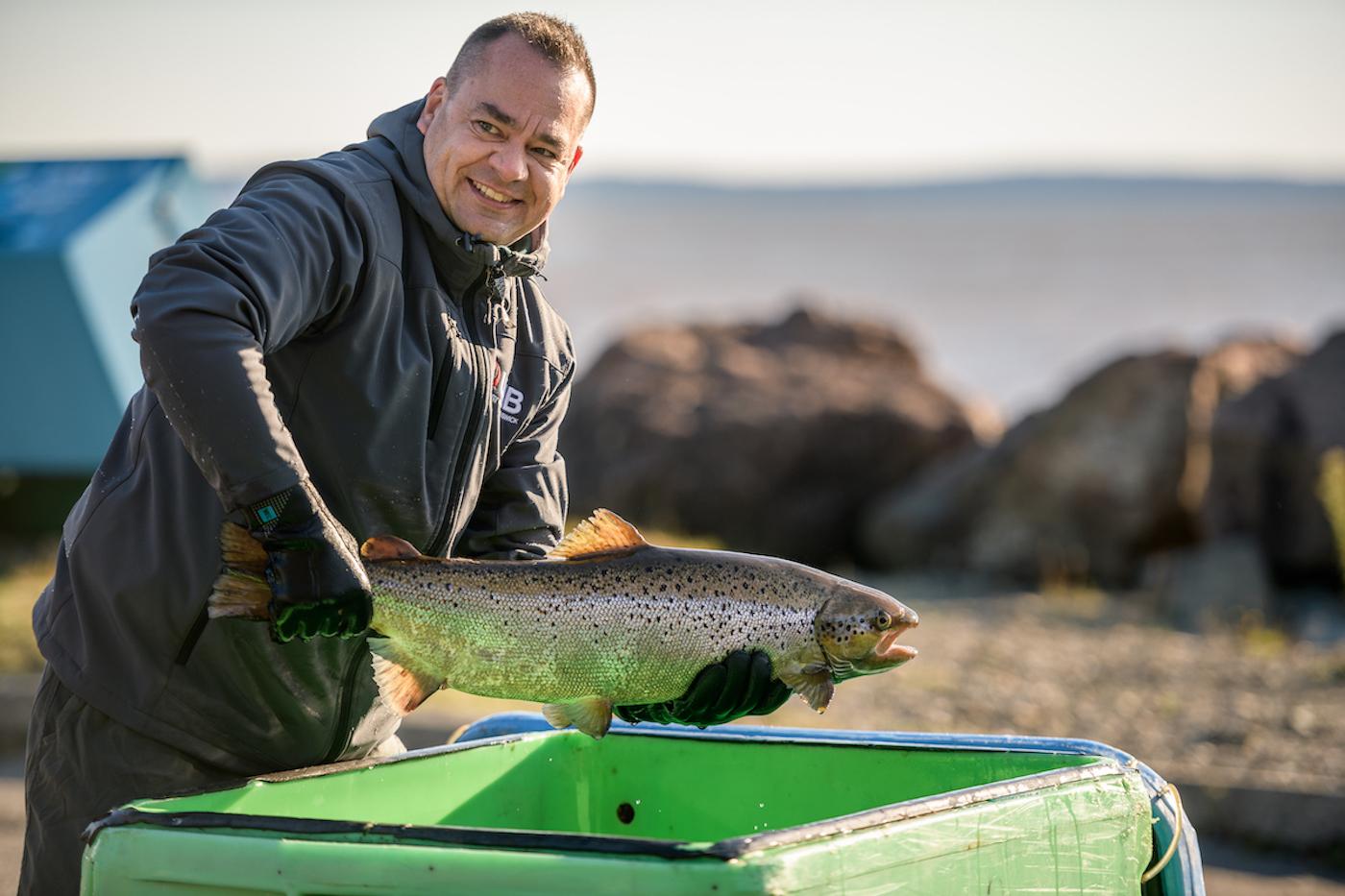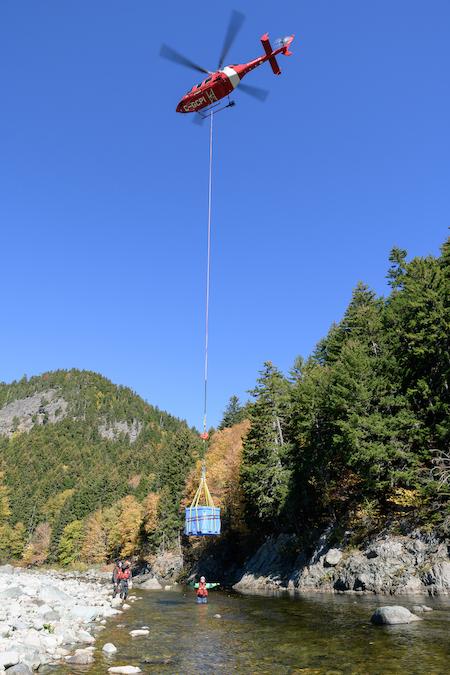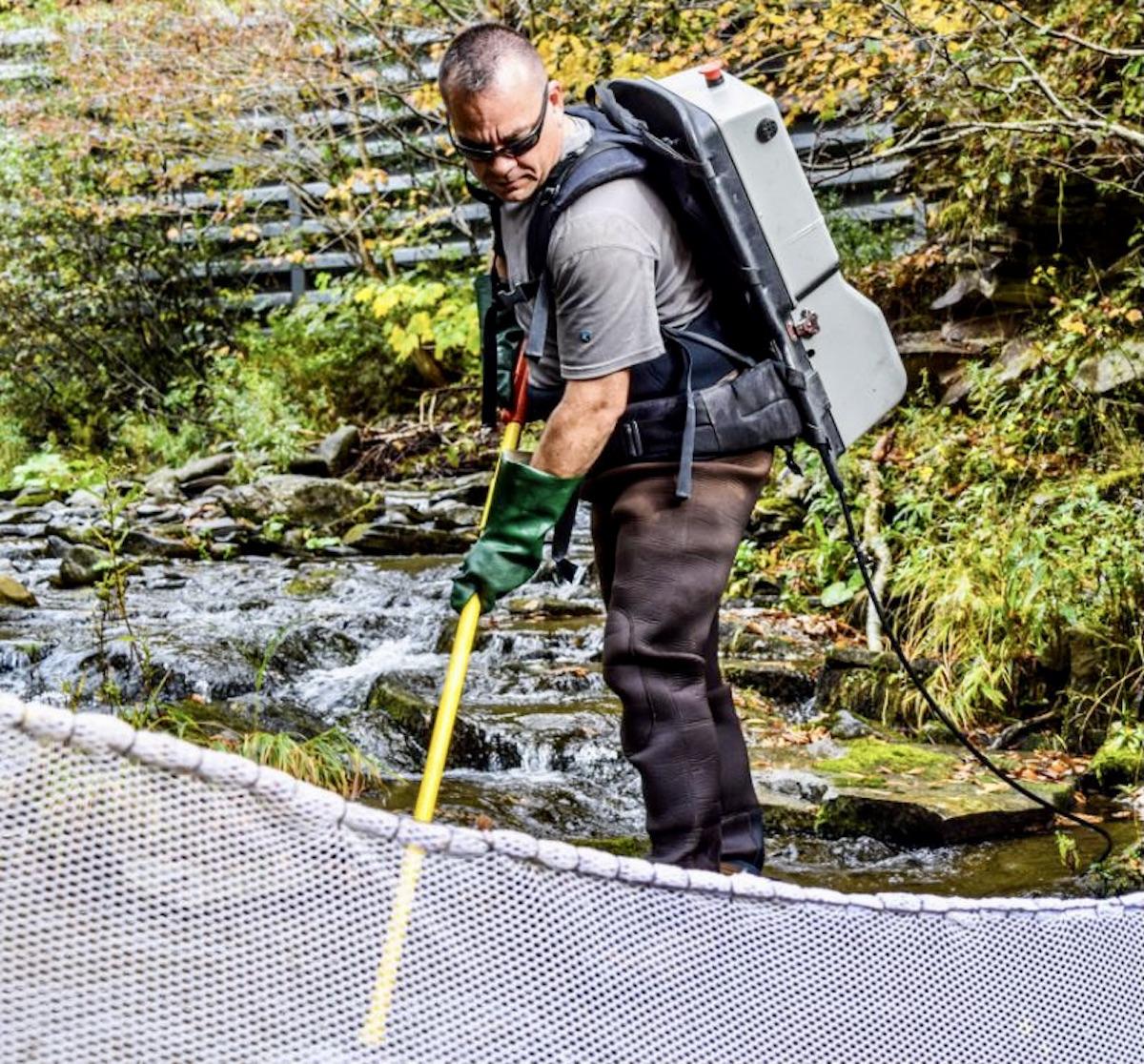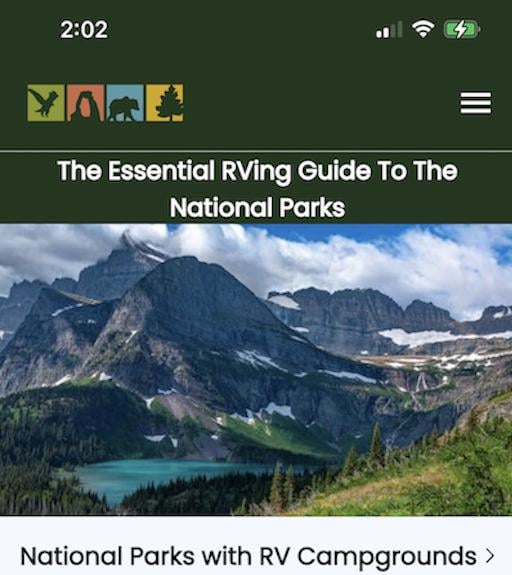
Kurt Samways loads a salmon into a tank to be lifted into the river by helicopter/Nigel Fearon Photography
Kurt Samways from the University of New Brunswick, has become Parks Canada’s first research chair in aquatic restoration and will work with five national parks in Atlantic Canada on conservation methods and ecological monitoring techniques to help protect and boost wild Atlantic salmon populations.
Samways, who holds a doctorate in biology with a specialization in freshwater ecology, will be studying the ecological effects of the Atlantic Salmon recovery work underway in Fundy National Park and Kouchibouguac National Park in New Brunswick, Cape Breton Highlands National Park in Nova Scotia, and Gros Morne National Park and Terra Nova National Park in Newfoundland and Labrador.
“Salmon are an iconic species and they’re deeply rooted in Atlantic Canadian culture, and so there’s that deep connection and as salmon start to disappear, we lose that connection,” Samways said in an interview from his home in Fredericton. “But there is also a strong ecological importance. If we lose salmon, we don’t just lose salmon. If you go to a national park, you want to see everything how it’s supposed to function naturally.”
When Samways started visiting Fundy, he didn’t see salmon swimming in its rivers. Now, without fail, a visitor runs up to him and says they’ve spotted one and want to know if it’s real. “It’s pretty special to have those kinds of interactions.”
Although Samways’ appointment was only announced in late 2020, he actually started work in September 2019. A media blackout during the federal election and then the Covid-19 pandemic delayed the official announcement.
“Restoring our wild Atlantic salmon populations will strengthen our economy and our ecosystems,” Minister of Fisheries, Oceans and the Canadian Coast Guard Bernadette Jordan said in a news release. “Our government understands that it’s not enough to just protect the existing stocks, we need to actively rebuild them.”

Kurt Samways directs a helicopter pilot where to land a load of 30 Atlantic salmon/Nigel Fearon Photography
Samways is originally from land-locked Saskatchewan but got his Masters of Biology from the University of Regina and likes to say that “somehow a Prairie boy got hooked on salmon.” His PhD studied the interaction between four anadromous fish — Atlantic salmon, rainbow smelt, sea lamprey and alewife (river herring) — and freshwater ecosystems. Anadromous fish migrate between freshwater and saltwater. Atlantic salmon, however, don’t typically die after they return to rivers to spawn like their Pacific salmon counterparts do.
During a 2015 talk about his research, Samways was approached by Fundy biologist and resource conservation manager Corey Clarke and got involved with their ecological restoration project. The Inner Bay of Fundy salmon population was first listed as endangered under the Species at Risk Act in 2003. The Fundy Salmon Recovery Project — which brings together government, Indigenous community members, academia and private industries — raises and releases wild salmon in three rivers.
“These salmon really do play a keystone role in rivers,” said Samways. They boost freshwater productivity that creates more algae and biofilm, which translates to more stream invertebrates (bugs and insects), which in turn translates to bigger and healthier salmon and “a positive ecological effect.”
Even so, Fundy is still “on the critical end” with only about 225 salmon in its rivers. On the other end of the salmon population spectrum, Samways said Terra Nova has a “recovered river” with more than 2,000 returning salmon.
All five Atlantic Canada parks are doing salmon and ecological river restoration work. Creating a research chair position puts them under one umbrella and to look at common metrics like the amount of biofilm and stream invertebrates. There will also be electrofishing to collect biological data and caudal fin clips.
“The idea is to look at how productive these ecosystems are and how are they changing in response to the salmon recovery efforts,” explained Samways.
Part of his job will be to help determine when to intervene to have the best impact on the salmon population, but since it’s an academic appointment he’s also teaching (virtually for now) ecology and environmental biology.
Due to Canada-wide Covid restrictions in national parks, Samways and his two grad students couldn’t start field work and meet all the key players until late June in New Brunswick and in mid-August in the other two provinces.
“We toured the rivers, picked out sampling sites, went through sampling protocols and did one dry run,” said Samways. “We’re now ready to start the research sampling as early as May or June and into November.” He will have one grad student (who will handle data analysis) and several summer students, and will of course draw on the work being done by resource conservation staff in each of the five parks.
Fundy already has a unique Swim with Salmon program that allows a limited number of citizens to join Parks Canada biologists during snorkel surveys. Samways said there are plans to customize and increase visitor experiences surrounding salmons at the other four parks.
The federal government has invested $4.1 million ($3.2 million USD) in Parks Canada’s five-year regional Atlantic salmon recovery project. It has also created web content to promote research opportunities. “This is a five-year appointment,” said Samways. “Hopefully I can demonstrate my worth and maybe we can extend it and go from there.”

Kurt Samways electrofishes for Atantic salmon parr, which are juvenile salmon/Parks Canada



Add comment